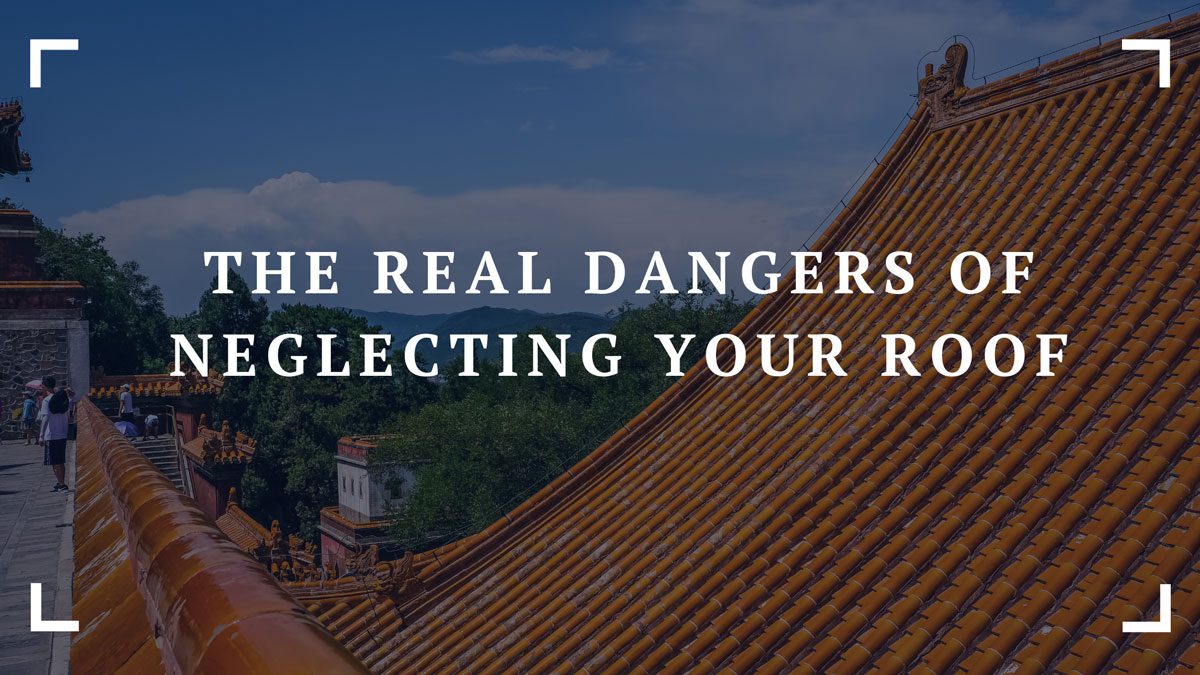Your roof is the pinnacle of your home. The crowning achievement of those who built it. Your stalwart protector and the final piece of insulation for energy efficiency. Most West Chester homeowners understand how important their roof is, yet maintaining a roof and having it inspected often slips people’s minds. Did you know that experts advise having your roof expected once a year minimum? Or that you should always at least look it over after a storm, hail, or the snow melts off? A neglected roof can not only lead to costly repairs but also endanger you, your family, and anyone who enters your home. In this article, we’ll discuss the dangers of a neglected roof and the steps you can take to stay on top of its condition and hopefully avoid severe damage.

Water Damage
One of the most common issues that can arise from a vulnerable roof is water damage. The smallest leak can lead to significant damage over time, even mold! Water can seep into your walls, ceilings, and floors. It can soak your insulation, condensate on your walls, and cause your paint to peel. It’s also in danger of reacting with your electrical wiring if it finds even the smallest exposure in a wire or socket. If it gets to the point of molding, you have an incredibly expensive repair ahead of you— you’ll also need to leave your home until the experts deem it safe. Mold exposure can severely harm your health, especially black mold, and must be cleaned by professional mold remediation teams.
Structural Damage
Over time, your roof may struggle to keep its shape— especially after our heavy snowfalls here in West Chester. Snow, debris, and ice can all weigh heavily on a roof, and a vulnerable or weak roof is more likely to collapse under the strain. This poses a significant risk to your safety and may damage other areas of your home while exposing them to the elements and further risks. One of the best times to have your roof inspected is in the spring, once all the snow thaws, since heavy snow and ice are leading causes of damage. It’s pretty simple to add a roof inspection to your seasonal checklist.
Pest Infestations
Damaged and neglected roofs invite guests. Rodents, insects, and birds can gain access to your home and can be difficult to remove. They can also cause a lot of damage! Rodents, for example, have been known to chew on wood and wires, and bird droppings are a pain to get out of wood. Certain insects can significantly damage your home, like termites or carpenter ants.
Decreased Energy Efficiency
Remember when we said your roof was the last piece of insulation for your home’s energy efficiency? Leaks and other damage allow air to escape, reducing the effectiveness of your HVAC and causing it to work harder. This leads to higher utility bills and a less comfortable home; it can also lead to a build-up of humidity.
Decreased Home Value and Curb Appeal
Since vulnerable roofs can pose a risk to the rest of your home, repair and replacement costs are factored into the appraisal— and some buyers will walk away instead of committing to repairs and inspections. Obviously, damaged roofs also affect the appearance of your home, reducing its aesthetics and curb appeal.
Signs Your Roof is Damaged
While yearly and after-event inspections can help you stay on top of the condition of your roof with professional help, there are also things that you can watch for which will indicate if your roof needs help.
- Leaks: If you notice water stains on your ceiling or walls, it may be a sign that your roof has a leak. This needs to be addressed quickly to mitigate any damage. Remember, water stains can also be a sign of plumbing trouble— pay attention to where the stain is to determine the most likely cause.
- Missing or Damaged Shingles: If you notice gaps in your shingles, your roof is likely compromised. Shingles are the main layer of protection against the elements.
- Sagging Roofline: A roofline should be straight across and level. If you start to notice your roof buckling, bending, or sagging, get out of your home and call a reputable West Chester roofing team ASAP! Your roof could collapse.
- Granules in Gutters or On Ground: If your shingles have started shedding granules, they are deteriorating and need replacement. A few bits every now and again isn’t an emergency, but finding a significant amount is. Generally, they get caught in your gutters, but not always.
- Cracked or Damaged Flashing: Flashing is what seals the joints and edges of your roof. Cracks or other damage can lead to water leaks.
- Increased Energy Bills: If you notice your energy bills are continuing to climb despite your best efforts, get an energy efficiency inspection. They can take a look at all aspects of your home that impact your efficiency, including your roof, and let you know what’s happening. They can also provide suggestions to lower your energy usage.
Conclusion
It’s worth noting that sometimes, disaster strikes. Maintaining your roof doesn’t stop a tree from falling on it or hail from damaging it. But it can prevent other avenues of damage and ensure your roof stands up better if the worst should happen. Your roof is an important aspect of your home and deserves regular maintenance and inspection to protect it just as it protects you. Once you’ve found a reputable company, work closely with them to keep your roof in the best shape.


